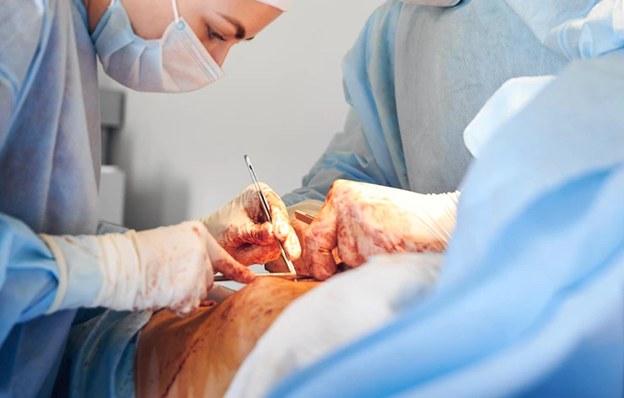
If you’re considering getting a tummy tuck, you might be wondering which type is right for you. There are a few types of tummy tucks but we will be looking at five.
In this blog post, we’ll break down the differences between each type of procedure so that you can make an informed decision about which one is right for you.
Types of Tummy Tuck Procedures
1. Standard Tummy Tuck
A standard tummy tuck (also called full abdominoplasty) is a surgical procedure that involves making an incision in the abdomen from hip to hip.
The skin is then lifted so that the underlying muscles can be tightened. This helps to give the stomach a flatter, more toned appearance. The excess skin is then trimmed away and the incisions are closed with stitches.
This type of tummy tuck is usually recommended for people who have loose skin around their stomachs due to significant weight loss or pregnancy.
2. Extended Tummy Tuck
An extended tummy tuck is a variation of the standard procedure that involves making an additional incision along the lower back.
This helps to tighten the muscles and skin in this area, in addition to the stomach.
This type of tummy tuck is usually recommended for people who have loose skin around their stomachs and lower backs due to significant weight loss or pregnancy.
3. Mini Tummy Tuck
A mini tummy tuck (also called partial abdominoplasty) is a less invasive surgical procedure that involves making a smaller incision in the lower abdomen. The skin is then lifted and the underlying muscles are tightened.
The excess skin is trimmed away and the incisions are closed with stitches. This type of tummy tuck is usually recommended for people who have small amounts of loose skin around their lower stomachs.
4. Circumferential Tummy Tuck

A circumferential tummy tuck, also known as a belt lipectomy or lower body lift, is a surgical procedure that involves the removal of excess skin and fat from the stomach area, as well as the hips, thighs, and buttocks.
The surgery can also involve the tightening of the abdominal muscles. Circumferential tummy tucks are typically performed under general anaesthesia and require a hospital stay of one to two nights.
5. Fleur-de-Lis Tummy Tuck
A Fleur-de-Lis tummy tuck, also known as an inverted-T or Brazilian abdominoplasty, is a surgical procedure that involves the removal of excess skin and fat from the stomach area, as well as the sides of the waist (love handles).
The surgery can also involve the tightening of the abdominal muscles. Fleur-de-Lis tummy tucks are typically performed under general anaesthesia and require a hospital stay of one to two nights.
Liposuction-Assisted Abdominoplasty

Liposuction-assisted abdominoplasty ( also called lipo-abdominoplasty) is a surgical procedure that involves making small incisions in the abdomen and inserting a small tube called a cannula.
The cannula is used to suction out fat from the abdomen. Once the desired amount of fat has been removed, the skin is lifted and the underlying muscles are tightened.
The excess skin is trimmed away and the incisions are closed with stitches.
This type of tummy tuck is usually recommended for people who have small amounts of fat around their abdominal area that they would like removed.
What Is The Difference Between A Standard And Extended Tummy Tuck?
The main difference between a standard and extended tummy tuck is the incision.
A standard tummy tuck involves making an incision in the abdomen from hip to hip, while an extended tummy tuck involves making an additional incision along the lower back.
What Is The Difference Between A Mini And Liposuction-Assisted Abdominoplasty ?
The main difference between a mini and liposuction-assisted abdominoplasty is the invasiveness of the procedure.
A mini tummy tuck is less invasive because it only involves making a small incision in the lower abdomen.
Liposuction-assisted abdominoplasty is more invasive because it involves making small incisions in the abdomen and inserting a small tube called a cannula.
Who Benefits From Each Type Of Tummy Tuck ?
Each type of tummy tuck has its own set of benefits.
Standard tummy tucks are beneficial for people who have loose skin around their stomachs due to significant weight loss or pregnancy.
Extended tummy tucks are beneficial for people who have loose skin around their stomachs and lower backs due to significant weight loss or pregnancy.
Mini tummy tucks are beneficial for people who have small amounts of loose skin around their lower stomachs.
Liposuction-assisted abdominoplasty is beneficial for people who have small amounts of fat around their abdominal area that they would like removed.
What Are The Risks Of A Tummy Tuck?

1. Excessive Bleeding
One of the risks of a tummy tuck is excessive bleeding. This can occur if the surgeon accidentally nicks or cuts a blood vessel during the procedure.
Excessive bleeding can lead to complications such as infection, bruising, and swelling.
2. Infection
Another risk of a tummy tuck is infection. This can occur if bacteria enter the incision site during or after the surgery. Infection can cause fever, redness, and pain at the incision site.
It can also lead to more serious complications such as sepsis, which is a potentially life-threatening condition caused by infection.
3. Blood Clots
Another potential complication of a tummy tuck is the formation of blood clots.
Blood clots can form in the veins of the legs or pelvis and can travel to the lungs, where they can cause a pulmonary embolism, which is a potentially life-threatening condition.
4. Numbness
Another possible complication of a tummy tuck is numbness in the abdominal area.
This can occur if the nerves are damaged during the surgery. Numbness may be temporary or it may be permanent.
5. Scarring
Another possible complication of a tummy tuck is scarring. The incisions made during the surgery will heal and leave scars that may be visible when wearing clothing that exposes the abdomen.
The scars may also be visible when lying down or sitting up.
6. Seroma
A seroma is another possible complication of a tummy tuck. A seroma is a collection of fluid that can form around the incision site.
Seromas can cause pain, swelling, and redness at the incision site
What Is The Recovery Time For Each Type Of Tummy Tuck?

The recovery time for each type of tummy tuck varies. Standard tummy tucks have a recovery time of 6-8 weeks.
Extended tummy tucks have a recovery time of 8-10 weeks. Mini tummy tucks have a recovery time of 4-6 weeks. Liposuction-assisted abdominoplasty has a recovery time of 4-6 weeks.
Which Type Of Tummy Tuck Is Right For Me?
The best way to determine which type of tummy tuck is right for you is to consult with a plastic surgeon that is experienced and reputable. He or she will be able to assess your case and recommend the best course of treatment.
Conclusion
There you have it! A breakdown of the three main types of tummy tucks: standard, mini, and liposuction-assisted abdominoplasty.
We hope this information helped decide which type of tummy fat removal procedure might be right for you. As always, be sure to consult with a reputable plastic surgeon in Singapore before making any decisions about surgery.